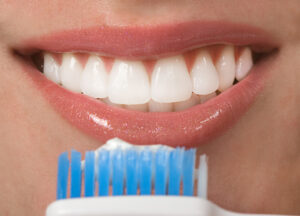How to Care for Your Porcelain Veneers
At Designer Smiles, we love creating beautiful smiles with porcelain veneers. Dr. Ann uses her many years of training and high level of skill, combined with her natural perfectionism, to give her patients the smiles of their dreams. In order for these new smiles to last for decades, there are important steps the patient must take in caring for the porcelain veneers.
Brush
 The teeth are not the only important factor in the appearance of a beautiful smile. The gums also play an essential role in the cosmetics of a smile. Beautiful, straight, white teeth surrounded by puffy, red, bleeding gums do not give the overall appearance of a nice smile. Gingivitis can ruin the cosmetics of your porcelain veneers. And it’s preventable!
The teeth are not the only important factor in the appearance of a beautiful smile. The gums also play an essential role in the cosmetics of a smile. Beautiful, straight, white teeth surrounded by puffy, red, bleeding gums do not give the overall appearance of a nice smile. Gingivitis can ruin the cosmetics of your porcelain veneers. And it’s preventable!
The edge of your veneers rests right at or just under the gum tissues, and this edge can be a collecting spot for dental plaque. Your job in caring for the veneers is to use a soft toothbrush in the right technique to remove the dental plaque twice every day. We love electric toothbrushes for their great ability to remove plaque, but you can achieve the same great results with a manual toothbrush.
First of all, you must have soft bristles because medium or hard bristles can scratch the veneer or damage your gums. The proper technique involves holding the bristles so that they meet the tooth and gums at a 45-degree angle and moving the brush in gentle circular motions to sweep plaque away from the gumline. Using a side-to-side or back-and-forth motion is not effective at removing plaque.
If you are unsure about how to perform the right brushing technique, ask Phyllis or Nancy for a demonstration at your next professional teeth cleaning. They love teaching patients how to use the right technique!
Floss
We have heard from some of our veneer patients that flossing makes them nervous. They feel that pulling the floss out could dislodge a veneer. Before we go into the importance of flossing, we will address this specific concern. You should never be able to pull off a veneer by flossing. If a veneer comes off during flossing, that means that its cement failed and it NEEDED to come off. You will actually be doing yourself a favor by pulling it off when you are paying attention. Otherwise, this failed-cement-veneer could come off when you are eating or in an otherwise inconvenient position.
If the reason you fear the veneer coming off is because you feel a “catch” or rough spot when you floss, come in for a visit with Dr. Ann. She will want to smooth any catches or rough spots away to make it easier and less stressful for you to floss!
Flossing is essential for removing plaque from between the veneers. Not only is this plaque a cause of gingivitis, as we discussed in the previous section on brushing; it also causes cavities. If a cavity develops between the teeth underneath a veneer, several problems can arise.
Cavities between the teeth can lead to shadowing or darkening of the appearance of the veneer, the veneer falling off, or the need for more aggressive treatment on the tooth (for example, removing the veneer and covering the tooth with a full crown). You cannot prevent cavities between the teeth without flossing!
Wear a Nightguard
 Most of our patients with porcelain veneers need to protect them by wearing a nightguard. A nightguard is a protective appliance that covers the upper teeth with a layer of hard acrylic that the lower teeth touch when you close your jaws together. By separating the teeth, it reduces the force of your jaw muscles and redistributes any biting forces to all of the teeth evenly. Patients who clench or grind their teeth are at a high risk for cracking, chipping, or dislodging their veneers. By wearing a nightguard every night, you can reduce or even completely eliminate that risk.
Most of our patients with porcelain veneers need to protect them by wearing a nightguard. A nightguard is a protective appliance that covers the upper teeth with a layer of hard acrylic that the lower teeth touch when you close your jaws together. By separating the teeth, it reduces the force of your jaw muscles and redistributes any biting forces to all of the teeth evenly. Patients who clench or grind their teeth are at a high risk for cracking, chipping, or dislodging their veneers. By wearing a nightguard every night, you can reduce or even completely eliminate that risk.
The nightguard also acts as a retainer, holding the teeth in their straight alignment. Wearing a nightguard consistently will keep the teeth from crowding or spreading out with small gaps between them.
Don’t worry. A professional nightguard is not a huge bulky thing. It is small and comfortable, covering your teeth by only a few millimeters.
It is also a great investment. The cost of a nightguard is less than half of a single veneer, and it can protect ALL of your veneers from damage.
Keep Consistent Follow-Up Visits
Another important aspect of caring for your porcelain veneers so that you give your new smile its longest lifespan possible is keeping up with consistent visits to the dentist. You need to see Phyllis or Nancy at least every six months for a professional teeth cleaning. This removes all bacterial buildup and reduces the risk for both cavities and gum disease. Dr. Ann will evaluate your veneers (as well as your entire oral cavity) in order to detect any warning signs of problems that could be prevented. These follow-up visits ensure the health of your veneers and the teeth underneath them.
More Questions about How to Care for Your Porcelain Veneers?
Call Designer Smiles today to schedule a consultation with Dr. Ann or a professional teeth cleaning with Phyllis or Nancy. Our goal is to help you enjoy your designer smile for a lifetime!
